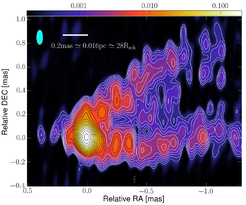Jae-Young Kim
PhD Thesis: Studies of nearest radio galaxies by global millimetre-VLBI observations
PhD Advisor: Dr. Thomas P. Krichbaum
Collaborators: Dr. R.-S. Lu, Prof. Dr. A.P. Marscher, Dr. I. Agudo, Dr. J.A. Hodgson, Dr. R.C. Walker, Prof. Dr. E. Ros, Prof. Dr. J.A. Zensus, and the EHT collaboration
The PhD project: Outflow phenomena are commonly seen in many compact astrophysical systems such as young stellar objects, micro quasars, and most remarkably, supermassive black holes (SMBHs) in active galactic nuclei (AGN).
AGN jets are particularly relativistic, extending from sub-pc to kpc scale from their central engine. The most intriguing questions with regard to these systems are; (i) how the AGN jets are initially launched, (ii) by which mechanisms the jets accelerate up to superluminal speeds, and (iii) what is the role of the magnetic field in these processes. My PhD thesis project is focused on observational studies of nearest radio galaxies where images of the base of the jets can be obtained at ultra-high angular and spatial resolution with global mm-VLBI techniques (e.g., 50 micro-arcseconds = 7 Schwarzschild radii (Rs) for M 87). Such high resolution observations particularly help distinguish several leading models for the jet formation and initial acceleration.

We have analyzed 86 GHz Global mm-VLBI array (GMVA) data of radio galaxies M 87 and 3C 84 to determine physical properties in the jet base region such as the core brightness temperature, width of the jet nozzle, relative brightness of the counter-jet, and the linear polarization properties. Participation of sensitive mm-VLBI stations such as the IRAM 30m telescope, phased Plateau de Bure interferometer, and the 100m Green Bank telescope
provided the source images at unprecedented sensitivity and resolution. Overall results from our analysis prefer magnetic energy dominated jet launching from inner portion of the accretion disk. However, complex transverse intensity profile of the innermost jet and frequency dependence of linear polarization suggest the presence of multiple plasma layers with intrinsically different physical properties (e.g., different magnetic field strength and particle density) and possibly their different origins.
I also partially contribute to the Event Horizon Telescope (EHT) project by supporting activities related to the test of new imaging algorithms for the forthcoming 230 GHz VLBI data.
About me: I come from Korea where I attended a regional high school and got interested in astronomy as a physical science. I studied rapid radio flux variability of active galactic nuclei at short mm-wavelengths as a BSc thesis project at Seoul National University. Later, I earned my MSc degree in the same university in early 2015 by multi-frequency spectral and polarimetric VLBI studies of selected AGN using the Korean VLBI Network (KVN) at 22, 43, 86 and 129 GHz. With the main interest of studying the AGN jet systems at the highest resolution by global mm-VLBI, I joined the VLBI group at the MPIfR as an IMPRS PhD student in August 2015. The PhD thesis is to be completed in the middle of 2018.
